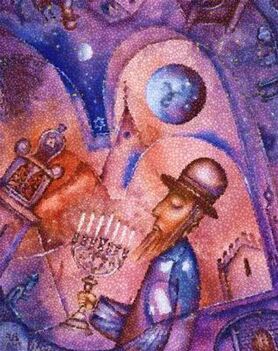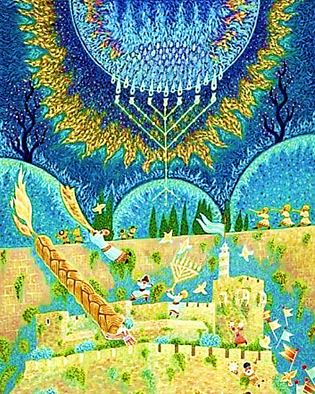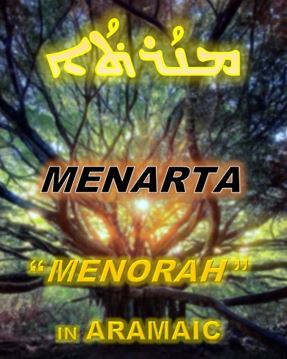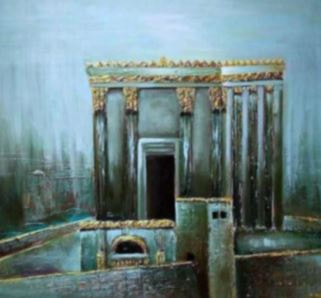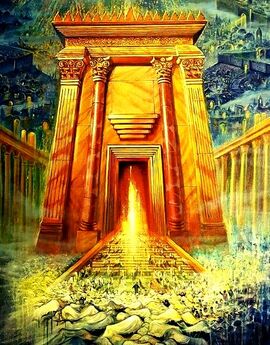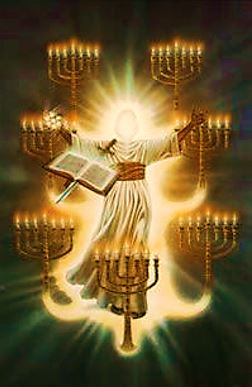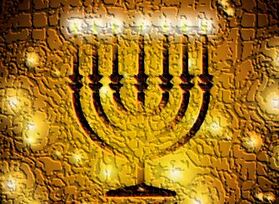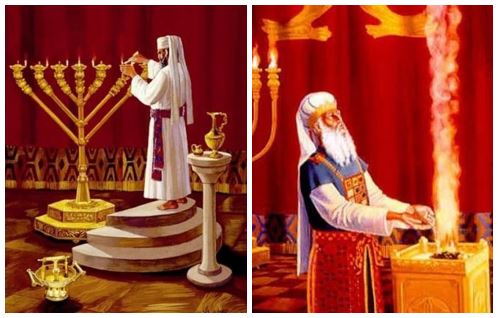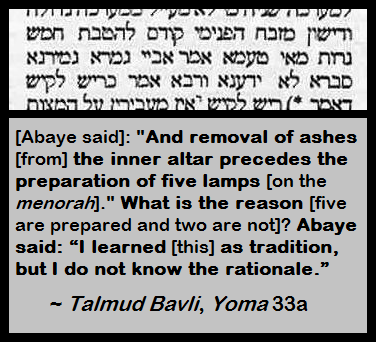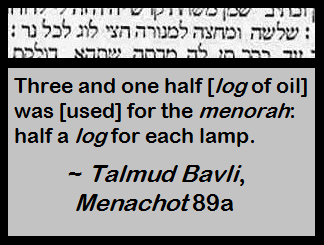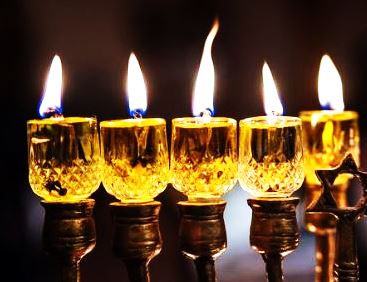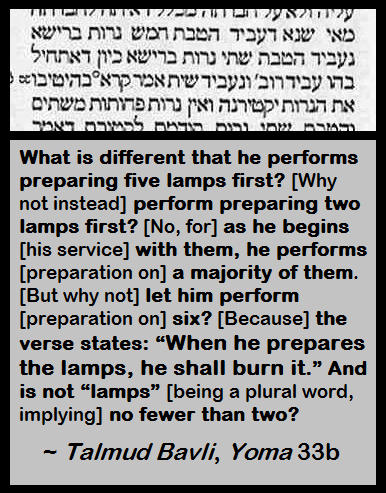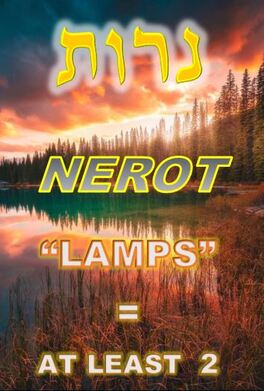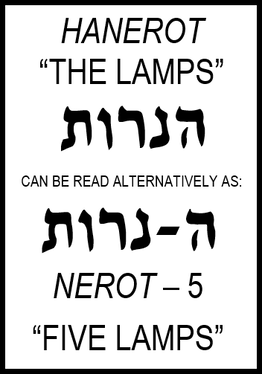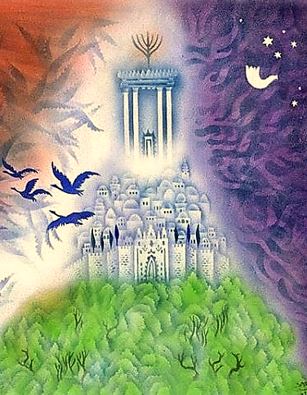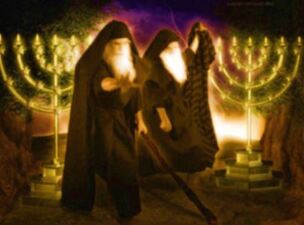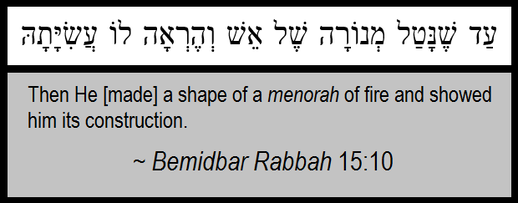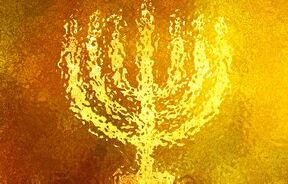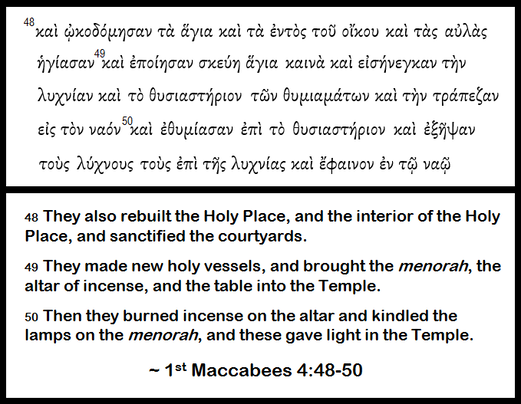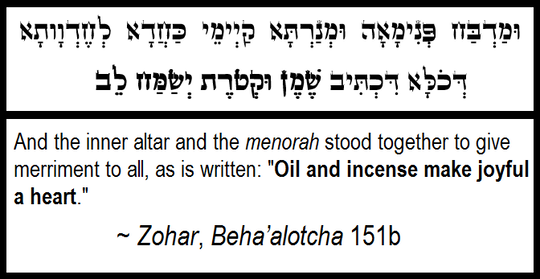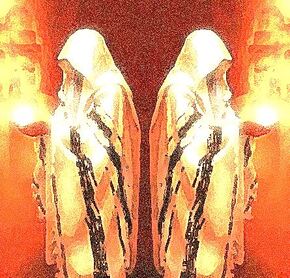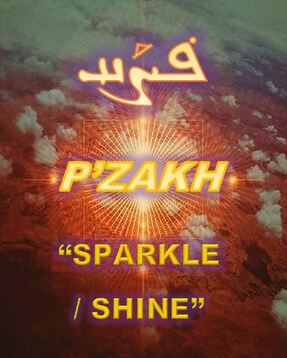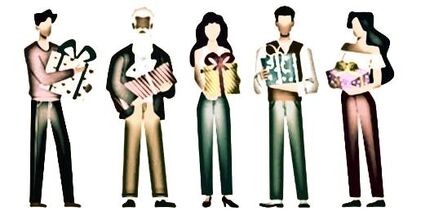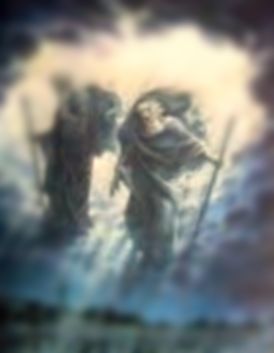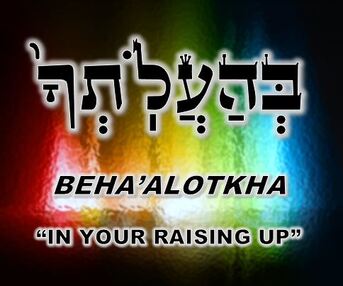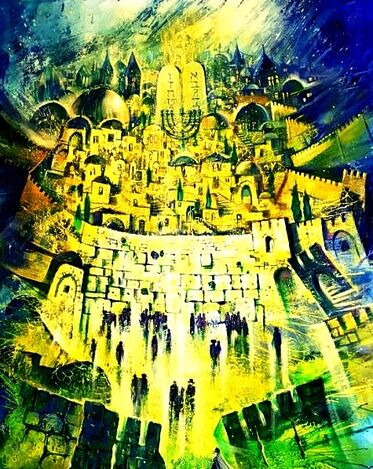THE CHANUKAH REVELATION
by Jeremy Chance Springfield
12/1/2020
The festival of Chanukah is directly mentioned only one time in the New Testament texts. In the Gospel of John chapter 10 is recorded the account of Yeshua appearing in the Temple during the festival of Rededication--Chanukah in Hebrew. The context and interactions recorded in that encounter are filled with significant Chanukah themes that would have been obvious to any first century believer reading the passage.
The festival of Chanukah is indirectly mentioned in the Gospel of Matthew chapter 24. In that passage is found explicit reference to the “Abomination of Desolation,” an event mentioned in the book of Daniel which prophesied the events that eventually lead to the Chanukah victory and the restoration of true worship in the land of Israel. Other subtle aspects of Yeshua’s words in that chapter hint that He was referring to the events surrounding the Chanukah account, as well as another future desecration of the Temple.
It may come as a surprise, however, to find a veiled but complex reference to Chanukah in none other than the book of Revelation. Since so much of the apocalyptic text has a framework in the Biblical holy days commanded in the Torah’s book of Leviticus 23, it really should not be so shocking that Chanukah appears to be included in it, as well.
It may come as a surprise, however, to find a veiled but complex reference to Chanukah in none other than the book of Revelation. Since so much of the apocalyptic text has a framework in the Biblical holy days commanded in the Torah’s book of Leviticus 23, it really should not be so shocking that Chanukah appears to be included in it, as well.
This study will focus on illuminating that Chanukah presence in the book of Revelation. In doing so, we will be able to appreciate better what the unique imagery is conveying to believers across the millennia--and what to expect and how we must be prepared to stand firm in the faith as the prophetic plan of redemption unfolds. If the reader is unfamiliar with the Biblical foundation of Chanukah, such as its establishment in the Torah and an overview of its historical nature, as well as more information concerning the spiritual nuances of the holy time, I highly encourage first reading this study: Dedicate the House.
The major allusion to Chanukah in Revelation is found in the very first chapter of the book. Revelation 1:11-20 sets the stage for us to appreciate the imagery as being that of Chanukah. I have translated those verses afresh from the ancient Aramaic of the Crawford Codex due to the nuances preserved within it. The revelator hears a heavenly voice explaining to him what his task will be.

11 ...“These that you see you must write in a book, and send to the seven assemblies: to Efesas, and to Zmurna, and to Pergamas, and to Tha’atira, and to Sardis, and to Filadelfiya, and to Ladiqiya.”
12 And I turned to know the voice which had spoken with me, and when I turned around, I saw seven menorahs of gold.
13 And in the middle of the menorahs was as the likeness of the Son of Man, and He was clothed [with] the ephod, and bound near His chest was a binding of gold.
14 Yet, His head and His hair were white as wool, and as snow, and His eyes were as the flame of fire.
15 And His feet were in the likeness of Lebanese brass that was burned in a furnace, and His voice was as the sound of many waters.
16 And in His right hand were seven stars, and from His mouth went forth a sharp spear, and His appearance was as the sun showing in its strength.
17 And when I saw Him, I fell near His feet, as dead, and He set upon me His right hand, saying, “Do not fear; I am the First and the Last,
18 and who lives, though was dead. And see! I am alive for eternity everlasting! Amen! And I have the key of death and of She’ul.
19 Therefore, you must write what it is that you have seen, and these that are, and are prepared to be after these:
20 the secret of the seven stars that you saw upon My right hand, and the seven menorahs. The seven stars are the angels of the seven assemblies, and the seven menorahs of gold that you saw, they are the seven assemblies.”
12 And I turned to know the voice which had spoken with me, and when I turned around, I saw seven menorahs of gold.
13 And in the middle of the menorahs was as the likeness of the Son of Man, and He was clothed [with] the ephod, and bound near His chest was a binding of gold.
14 Yet, His head and His hair were white as wool, and as snow, and His eyes were as the flame of fire.
15 And His feet were in the likeness of Lebanese brass that was burned in a furnace, and His voice was as the sound of many waters.
16 And in His right hand were seven stars, and from His mouth went forth a sharp spear, and His appearance was as the sun showing in its strength.
17 And when I saw Him, I fell near His feet, as dead, and He set upon me His right hand, saying, “Do not fear; I am the First and the Last,
18 and who lives, though was dead. And see! I am alive for eternity everlasting! Amen! And I have the key of death and of She’ul.
19 Therefore, you must write what it is that you have seen, and these that are, and are prepared to be after these:
20 the secret of the seven stars that you saw upon My right hand, and the seven menorahs. The seven stars are the angels of the seven assemblies, and the seven menorahs of gold that you saw, they are the seven assemblies.”
This passage is not usually one that would be interpreted to be possessing any reference to Chanukah at all. The text is normally approached from a Greek manuscript and Christian viewpoint, but if an Aramaic manuscript and a Jewish viewpoint is utilized, it takes on a distinct Chanukah tone that can help us to appreciate the messages contained here in a way that provides better context regarding what is written.
This Chanukah tone is most prominently seen in the usage of the Peshitta’s word MENARTA, being the Aramaic cognate for the Hebrew MENORAH.
This Chanukah tone is most prominently seen in the usage of the Peshitta’s word MENARTA, being the Aramaic cognate for the Hebrew MENORAH.
An important detail regarding the history of Chanukah—besides the intense persecution of the faithful in the form of preventing performance of the commandments—was the halting of Temple activities by the Seleucids. In an unprecedented move, they removed the Temple’s golden menorah “lampstand,” among other holy articles—immediately preventing righteous and Torah-ordained worship from occurring. Not only were commandments being outlawed, but so also was the righteous worship being attacked. The threat was real and the war reached from flesh to spirit--and something had to be done.
Through the actions of priests and multitudes of zealous faithful across Israel, men took up the sword to fight for the right to worship, and in doing so, although the odds were staggeringly against them, they regained control of the Temple, enacting true worship that would welcome once more the Presence of the Holy One, and continue through the years to allow even the Messiah Yeshua entrance to His Father's House that He might fulfill prophecies necessary for His own ministry to stand as legitimate before the people.
In accordance with the Torah, the altar of incense and the menorah were the first things to be “reactivated” once control of the Temple was regained and the Biblically mandated dedication of the Holy House enacted. For this reason, the book of Revelation’s mention of a vision of seven menorahs is very interesting.
Through the actions of priests and multitudes of zealous faithful across Israel, men took up the sword to fight for the right to worship, and in doing so, although the odds were staggeringly against them, they regained control of the Temple, enacting true worship that would welcome once more the Presence of the Holy One, and continue through the years to allow even the Messiah Yeshua entrance to His Father's House that He might fulfill prophecies necessary for His own ministry to stand as legitimate before the people.
In accordance with the Torah, the altar of incense and the menorah were the first things to be “reactivated” once control of the Temple was regained and the Biblically mandated dedication of the Holy House enacted. For this reason, the book of Revelation’s mention of a vision of seven menorahs is very interesting.
This is because Yeshua referred to Himself as the “light,” as John 9:5 records.

So long as I am in the world, I am the light of the world.
This assertion is significant, for while although not usually explained as such, the Messiah said this statement during the season of Chanukah. In fact, upon closer inspection of the content in this verse and what follows and leads to the event at Chanukah in the next chapter, there is very little time elapsing at all—essentially only hours, at the most—between this statement of Him being the light and the events recorded at the Temple as beginning in John 10:22, which are explicitly stated to have happened at Chanukah.
Therefore, for Revelation to speak of the seven menorahs, and to know that Yeshua claimed to also be a light, we see that Revelation chapter 1 displays seven sources of light--plus one more, giving us a total of eight sources of light! This is significant in that the traditional timeframe for Chanukah involves a period of eight days, and those days are commemorated by families lighting a special menorah of eight lamps in their homes, rather than the menorah of seven lamps that is only allowed to be lit in the Temple itself.
When this detail is understood, we can see the concept of Chanukah embedded in the opening words of the book of Revelation!
This allusion is not the end, however. What immediately follows this description of seven menorahs and the Messiah (Light) in their midst also strongly connects to Chanukah. Revelation chapters 2-3 consist of letters written to seven assemblies scattered throughout the Roman empire during the first century. These seven assemblies were represented in chapter 1:20 by the seven menorahs shown in the vision.
The astute reader might see something interesting in the nature of the messages given to the seven assemblies. While each assembly received its own personalized address, the nature of the letters can be divided into two groups: praise and admonishment, and only praise.
Of the seven assemblies, five receive letters containing a mix of praise and admonishment for their behavior. Only two are not disciplined at all but are left only with praise for their behavior: Smyrna and Philadelphia.
This allusion is not the end, however. What immediately follows this description of seven menorahs and the Messiah (Light) in their midst also strongly connects to Chanukah. Revelation chapters 2-3 consist of letters written to seven assemblies scattered throughout the Roman empire during the first century. These seven assemblies were represented in chapter 1:20 by the seven menorahs shown in the vision.
The astute reader might see something interesting in the nature of the messages given to the seven assemblies. While each assembly received its own personalized address, the nature of the letters can be divided into two groups: praise and admonishment, and only praise.
Of the seven assemblies, five receive letters containing a mix of praise and admonishment for their behavior. Only two are not disciplined at all but are left only with praise for their behavior: Smyrna and Philadelphia.
This distinction of two out of the seven is important, for the Torah speaks of an odd method of daily Temple service that helps us to understand this very detail. While speaking of the commandments concerning the altar of incense that sits in the Holy Place before the veil of the Holy of Holies, Exodus 30:7 preserves a unique aspect of the daily high priestly act that also concerns the menorah.

And Aharon shall burn over it sweet incense in the morning. In the morning, when he prepares the lamps, he shall burn incense upon it.
The text of the Torah presents a quandary—one that is easy to miss if we are not careful with assessing how it is worded. The text seems to have the high priest performing two different functions at once, and yet that is impossible: he cannot burn incense over the altar of incense and simultaneously prepare the lamps of the menorah for new oil and wicks.
So, what does this mean?
The text of the Talmud attempts to explain.
The text of the Talmud attempts to explain.
We see here the introduction of a new piece of information: during the morning worship service, the alter of incense was prepared for the new day, and then so was the menorah, having five its lamps similarly prepped for new usage. This prepping involved refilling the oil which fuels the menorah’s lamps. The amount of oil used for this, so the Talmud tells us, was very specific.
This amount is precise, and we shall find it is important to the topic as the study develops. What is still of interest, however, is that the Talmud says that only five of the seven lamps were prepared at first.
That text continues and attempts to understand why the priests would have staggered the preparations of the lamps of the menorah in such an odd way, offering various reasons, and finally presents the following as an attempted explanation for the method.
In this somewhat complex train of thought, the reason for staggering the preparation of the lamps of the menorah in the morning in a five and then two sequence is all bound up in a grammatical nuance preserved in the text of the Torah, which is quoted at the end, from Exodus 30:7, previously quoted in full in this study. The Hebrew word for “lamps” is NEROT, and is the plural of NER “lamp.” Since the smallest plural of a thing can only be two, NEROT is assumed to imply that two lamps at a time are the smallest number that can legally be prepped at once. Therefore, if two was the smallest number that could be prepped, then the most that could be prepped at a time on the seven-branched menorah would be five. The logic holds out quite well.
The same conclusion of why five were dealt with first can be arrived at also from a slightly different approach: the precise word found in the Torah for “the lamps” in Exodus 30:7 is pronounced HANEROT. Interestingly, the term “the” is merely the Hebrew letter Heh attached to the word NEROT “lamps,” and since Hebrew is an alpha-numeric language, the letter Heh has the numeric value of 5, which means that the text could alternatively be understood as “When he prepares five lamps, he shall burn it…”
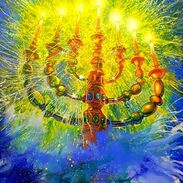
Either way it is approached, the ancient reasoning of the priests that resulted in them breaking up the preparation of the lamps on the menorah into a 2/ 5 sequence is thus seen to be justified based on the nuances of the Torah text.
When this menorah factor of five and two is understood, we can appreciate better the presentation in Revelation chapters 2-3 of the seven assemblies, with five being disciplined and two being left with only praise. Five lamps had to be cleaned and their wicks trimmed so they could continue to burn properly, just as five of the seven assemblies required disciplining so that they could properly stand as witnesses before the Creator.
Each of the seven assemblies / menorahs addressed in Revelation were in a struggle against assimilation and the threat of allowing idolatry and deception to do irreparable damage to the true faith. Such a reality of their situation mirrors the situation of the Jewish people facing the threat of Antiochus and his paganizing plan for Israel during the wars that preceded the victory of Chanukah. In all of this can be seen the importance of Yeshua’s words to the seven assemblies and His presence in their midst making a similar eight-branched menorah.
When this menorah factor of five and two is understood, we can appreciate better the presentation in Revelation chapters 2-3 of the seven assemblies, with five being disciplined and two being left with only praise. Five lamps had to be cleaned and their wicks trimmed so they could continue to burn properly, just as five of the seven assemblies required disciplining so that they could properly stand as witnesses before the Creator.
Each of the seven assemblies / menorahs addressed in Revelation were in a struggle against assimilation and the threat of allowing idolatry and deception to do irreparable damage to the true faith. Such a reality of their situation mirrors the situation of the Jewish people facing the threat of Antiochus and his paganizing plan for Israel during the wars that preceded the victory of Chanukah. In all of this can be seen the importance of Yeshua’s words to the seven assemblies and His presence in their midst making a similar eight-branched menorah.
Just as He claimed to be the light, He sought for them to also shine brightly as luminary witnesses. He says as much in Matthew 5:14-15, and the Aramaic of the Peshitta text holds in it a term that explicitly connects it to our topic.
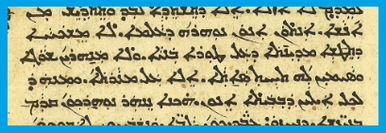
14 You are the light of the world. The city that is built upon the mountain is not able to be hidden.
15 And neither do they kindle the lamp and set it under a seah measure, but upon a menorah, and it illuminates all those who are in the house.
15 And neither do they kindle the lamp and set it under a seah measure, but upon a menorah, and it illuminates all those who are in the house.
We read from the Aramaic of verse 15 that the believer is compared to a menorah! This detail is not present in the Greek versions of this statement. Not only is the believer a light like Messiah, the believer is comparable to a menorah! We have a purpose to shine for Him to the world and publicize the miracle of the redemption of mankind.
Returning back to Revelation, we see this purpose being described in 11:3-5.
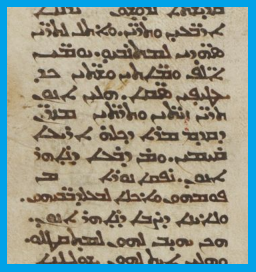
3 “And I shall give to My two witnesses, and they shall prophesy a thousand, and two hundred, and sixty days, while draped [with] sackcloth.
4 These are the two olive-trees, and the two menorahs who, before the Master of all the earth, are standing.
5 And he who seeks that he should harm them, fire goes out from their mouths and consumes their enemies. And those who desire to harm them, thus it is given to them to be killed.
4 These are the two olive-trees, and the two menorahs who, before the Master of all the earth, are standing.
5 And he who seeks that he should harm them, fire goes out from their mouths and consumes their enemies. And those who desire to harm them, thus it is given to them to be killed.
The identity of these two witnesses is one over which much speculation has been spent by seemingly all who have read Revelation’s enigmatic words. Whomever they may personally represent, we can perceive in the details provided here at least the intended identification from ancient times: there are only two of them, and they are referred to as menorahs! Knowing that seven menorahs were previously encountered in Revelation 1, and were explained to represent seven assemblies, and only two out of those seven were left without discipline in their letters, we can therefore logically conclude that the appearance of two witnesses who are likewise described as menorahs is showing us the same thing! The two witnesses are Smyrna and Philadelphia! What exactly this means for the fulfillment is not entirely clear. Due to the heavy symbolism of Revelation it is likely that the lofty spiritual attributes of the congregations originally in Smyrna and Philadelphia will be personified in two individual humans, although this remains to be seen for sure.
This also has a parallel in Judaism’s tradition regarding how the menorah was finally understood to be made. The text of Bemidbar Rabbah 15:10 explains that after having some difficulty with exactly how it should appear, the Holy One showed Moses the heavenly version of the menorah so he would understand better.
The heavenly menorah was of fire and the two witnesses—themselves described as menorahs—are said to possess the unique ability out of all prophets who have ever existed, to send forth fire from themselves to attack their enemies. This traditional understanding of the fiery nature of the heavenly menorah would not have been lost upon Revelation’s original Jewish readers.
All of this fits perfectly the Torah’s hint that the menorah was prepared along with the altar of incense in the morning service in a two / five staggered preparation. The apocryphal book of 1st Maccabees 4:48-50 cements this link between the altar of incense and the menorah by showing that even the restored priesthood paired the two together.
All was done in accordance with the Torah: the union of the altar of incense service and the menorah lighting was restored. It is important to acknowledge this detail in the events of the original Chanukah. This unique link between the menorah and the altar of incense is further perceived when we look closer at the names of the two assemblies who were in no need of discipline in Revelation chapters 2-3.
Smyrna and Philadelphia are the names of the two assemblies / menorahs who were only praised, and who are again represented in Revelation 11 by the two witnesses / menorahs.
The name Smyrna has the meaning of “Myrrh.”
The name Philadelphia means “Brotherly Love.”
The meanings of these two names are directly connected to the menorah and the altar of incense, as the two passages below clearly show.
Smyrna and Philadelphia are the names of the two assemblies / menorahs who were only praised, and who are again represented in Revelation 11 by the two witnesses / menorahs.
The name Smyrna has the meaning of “Myrrh.”
The name Philadelphia means “Brotherly Love.”
The meanings of these two names are directly connected to the menorah and the altar of incense, as the two passages below clearly show.
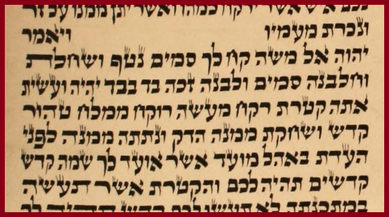
34 And YHWH said to Mosheh, “Take for yourself fragrances: myrrh, and onycha, and galbanum—fragrances—and pure frankincense. Of each equal measure.
35 And you shall make it incense, an ointment work of a perfumer, pulverized pure—holy.
36 And you shall beat some from it very small, and set [some] from it before the Testimony in the Tent of Meeting, wherein I meet you. There it shall be holy of holies to you.”
~ Exodus 30:34-36
35 And you shall make it incense, an ointment work of a perfumer, pulverized pure—holy.
36 And you shall beat some from it very small, and set [some] from it before the Testimony in the Tent of Meeting, wherein I meet you. There it shall be holy of holies to you.”
~ Exodus 30:34-36

1 A song of ascents. For David. Behold how good and how pleasant it is for brothers to dwell with unity.
2 It is as the good oil upon the head, descending upon the beard—Aharon’s beard—that descended upon the extremity of his garment.
~ Psalms 133:1-2
2 It is as the good oil upon the head, descending upon the beard—Aharon’s beard—that descended upon the extremity of his garment.
~ Psalms 133:1-2
This unique connection is further seen explicitly stated in Proverbs 27:9.

Oil and incense make joyful a heart, and the sweetness of a man’s neighbor is the counsel of the soul.
Even the Jewish text of the Zohar saw the special link here in this passage and the function of that connection between the altar of incense and the menorah.
All of this is significant to perceiving the concepts of Chanukah in the book of Revelation, and seems to find its fulfillment in the solemn Aramaic words of Revelation 11:9-10, which explain the reaction of idolaters after the two witnesses are finally murdered and their corpses left for all to see.
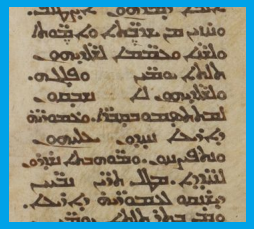
9 And peoples, and tribes, and tongues, and nations who see their carcasses, [for] three and a half days will not allow them to be placed in a grave.
10 And those inhabitants of the earth shall be merry over them, and they shall be glad, and shall send gifts to each other, on account of the two prophets who tortured the inhabitants of the earth.
10 And those inhabitants of the earth shall be merry over them, and they shall be glad, and shall send gifts to each other, on account of the two prophets who tortured the inhabitants of the earth.
Recalling that the amount of oil used to daily fuel the wicks of the Temple menorah was calculated from antiquity to be three and one half logs, we can see in the above passage the clear connection to the two witnesses, who are called menorahs, and whose death lasts for three and one half days! This parallel should not be lost on the reader. It would seem the actions of the evil ones, like Antiochus before them, are intended to eradicate true worship from the earth.
The Aramaic text in verse 10 also has another potential hint to the ironic nature of the response that points to when this happens: it is said of the people “and they shall be glad.” The term here is W’NETPAZKHUN, and while it is an inflection of the term P’ZAKH, usually translated as “glad,” it literally means in the Aramaic tongue “to sparkle / to shine.” Just as the two witnesses served as living lights / menorahs for the Holy One, in their death, they cause the corrupt people of the world to shine in their own tainted ways—revealing to all whom it is they truly serve.
This detail is also interesting when paired with the fact that the people of the world are said here to send gifts to each other at the time of the demise of these two menorahs. Chanukah very often falls during the season of Christmas, wherein not only are sparkling lights and shiny scenes abundant, but the giving of gifts is also a socially acceptable worldwide occurrence. The mention here in Revelation of being “merry” and the giving of gifts that spans cultures and borders seems to be a likely reference to the secularized version of Christmas, which is no longer only observed by Christians, but has been widely adopted by the world as a cultural holiday divorced from its spiritual origins. These details fit seamlessly with the Chanukah concepts of the two witnesses that have existed in the book of Revelation from chapter 1.
The deaths of these two witnesses, while a solemn thing, is lessened by the fact that the text goes on to tell us that they are revived in 11:11-12.
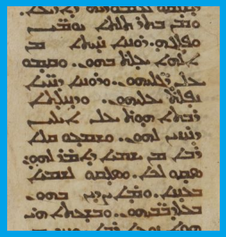
11 And from after three days, and a half day, the spirit of life from Alaha entered into them, and they rose upon their feet, and the spirit of life fell upon them. And great fear was over those who saw them.
12 And they heard a great voice from the heavens that said to them: “You must ascend here!” And they ascended to the heavens in a cloud, and their enemies stared at them.
12 And they heard a great voice from the heavens that said to them: “You must ascend here!” And they ascended to the heavens in a cloud, and their enemies stared at them.
Not only are they revived after three and a half days which corresponds to the amount of oil in log volume used for the menorah, but they ascend into the heavens in victory over their oppressors!
This resurrection and ascension are directly linked to the menorah and to Chanukah, as the Torah tells us in Numbers 8:1-2 that the lights of the menorah are to be dealt with in a very specific way.

1 And YHWH spoke to Mosheh, saying,
2 “Speak to Aharon, and say to him, ‘In your lighting of the lamps, the seven lamps shall illuminate over against the front of the menorah.’”
2 “Speak to Aharon, and say to him, ‘In your lighting of the lamps, the seven lamps shall illuminate over against the front of the menorah.’”
The term BEHA’ALOTKHA does not literally mean “lighting” at all, but rather, literally means “in your raising up,” and likely intends the trimming of the spent wicks and the raising of the newer portion to allow for further burning.
But more than just an act of wick prepping, this “ascension” phraseology is a hint to the resurrection of the dead, and thus, to the raising of the two witnesses in Revelation 11, who are referred to as menorahs! Just as the Temple service was destroyed and dead and was only restored at the relighting of the menorah, so also are the two witnesses destroyed and restored, and in that restoration, are lifted up to the heavens, lights who ascend like the wicks of the menorah are commanded to do in the Torah!
In these passages from Revelation we can see the context and imagery of Chanukah repeatedly presented to the reader. Although obscured by time and the comfortable cultural lens so often worn when reading, when we return to the ancient texts and remove the lens of modern interpretation, the presence of Chanukah in the book of Revelation becomes illuminated for all to see.
Like the priests who were steadfast in the threat of impending doom, we can see in the prophetic text of Revelation that we must be prepared to stand firm in performance of the Word, as well. Times of trouble await the world before the Kingdom is restored in its fullness. Commitment to the holy commandments, to worship in Spirit and in truth, is vital for the dark times we face. The text’s message of perseverance among persecution and the reward for a steadfast faith that shines His light of true worship can be seen brightly when the Chanukah revelation is at last realized.
Like the priests who were steadfast in the threat of impending doom, we can see in the prophetic text of Revelation that we must be prepared to stand firm in performance of the Word, as well. Times of trouble await the world before the Kingdom is restored in its fullness. Commitment to the holy commandments, to worship in Spirit and in truth, is vital for the dark times we face. The text’s message of perseverance among persecution and the reward for a steadfast faith that shines His light of true worship can be seen brightly when the Chanukah revelation is at last realized.
All study contents Copyright Jeremy Chance Springfield, except for graphics and images, which are Copyright their respective creators.
